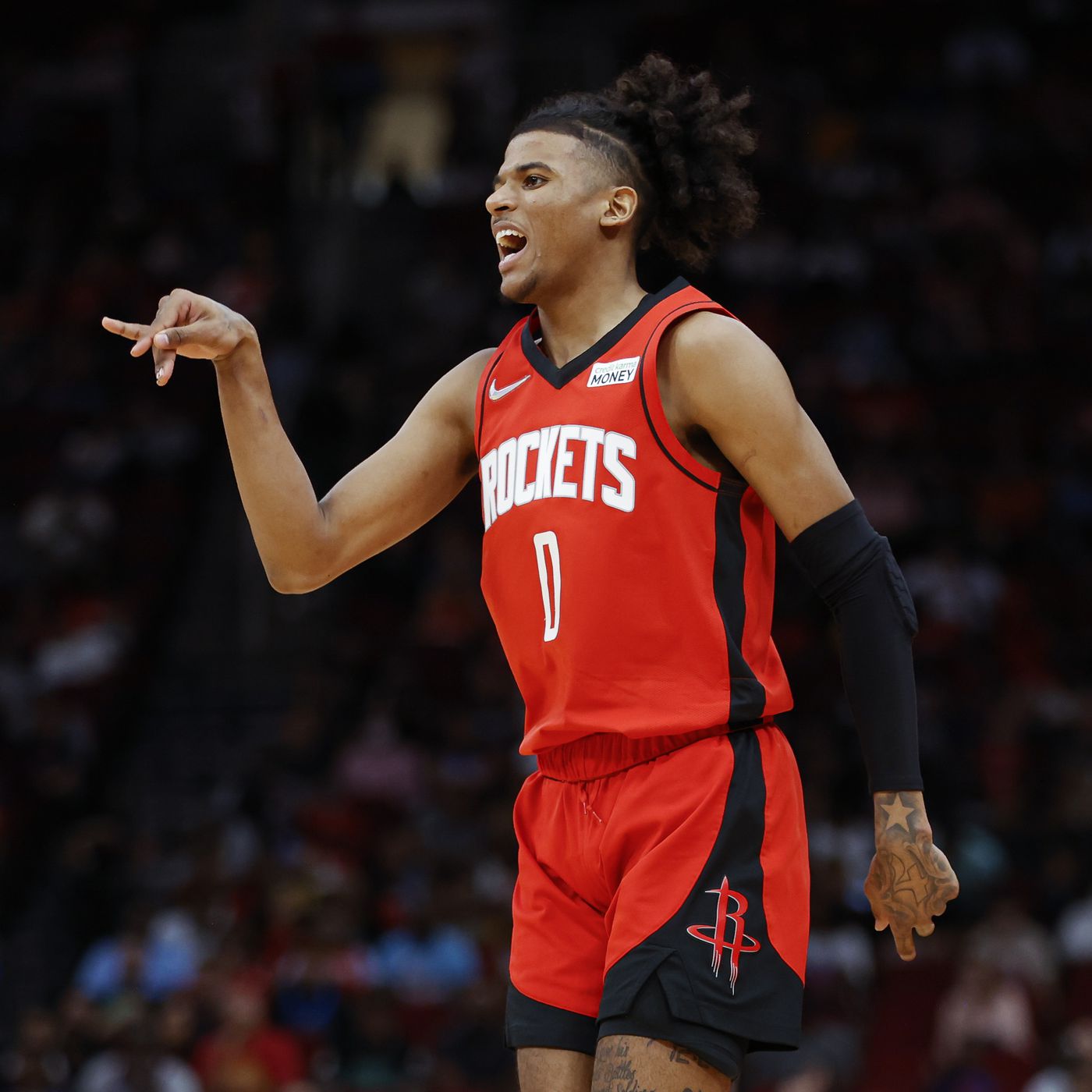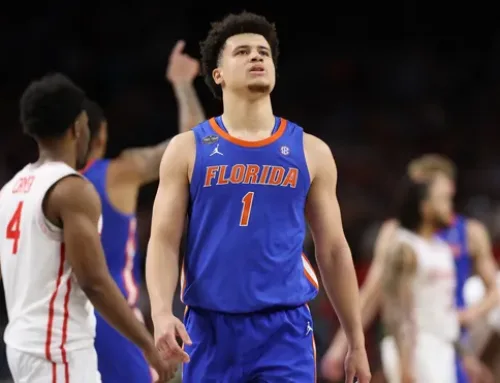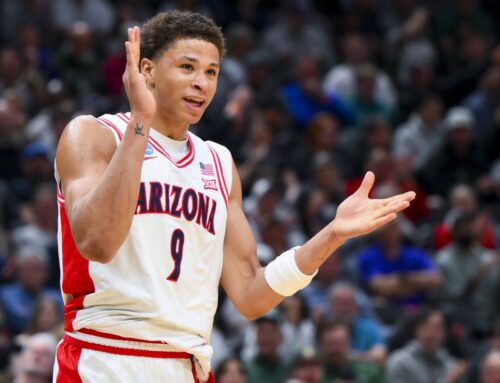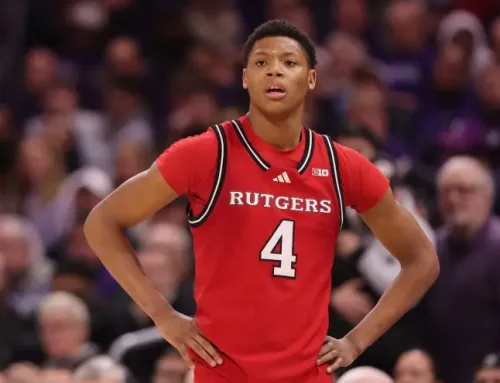By Avi Tyagi
Tier 7: He Scores; He Must Do More
Jalen Green
Here is the list of players since the merger with a usage rate above 25%, a free throw percentage above 78%, an average of 5+ free throw attempts per game, and an average of 3+ assists per game for an entire season with an AST to TO ratio greater than 1:1 who are 22 or younger:
Michael Jordan, Stephon Marbury (2x), Kobe Bryant (3x), Carmelo Anthony, Russell Westbrook (2x), Derrick Rose, Eric Gordon, John Wall, Devin Booker (3x), Trae Young (3x), Donovan Mitchell, Brandon Ingram, Jayson Tatum, Collin Sexton, Shai Gilgeous-Alexander, Jalen Green
That’s an incredibly impressive list littered with All-Stars and Hall of Famers. However, here are the 3 players in that sample whose teams were scored by more than 8 points per 100 possessions when they were on the court:
2017-18 Devin Booker, 2020-21 Collin Sexton, 2022-23 Jalen Green
Of the three, Jalen Green had the lowest true shooting percentage by far and was definitely the worst defender. Herein lies the Jalen Green conundrum. He scores a lot, his first step is impressive, but his shot selection is messy and his defense regressed in year 2. For Jalen Green to become an All-Star, he must defend at a remotely acceptable rate. Jalen Green too often simply stood and watched on defense last season, leading to stretches of 4 v 5s in half-court settings. He’s not particularly apt at maintaining proper technique on-ball, nor is he so attentive to effectively chase players off screens. He’s a career 80% from the line with a low release point, similar to Jordan Poole’s shot in 2022-23. As seen from the results with Jordan Poole, a lower release point can and will be the factor that batters the percentages on contested shots out at the perimeter. In essence, there’s a lot for Jalen Green to work on. As a defensive rebounder, point of attack defender, pure shooter, and efficient shot taker within the flow of a more pass-happy offense, he must improve significantly to validate his potential. I have him here due to the upside, but it’s up to him to maximize it. Hopefully, the new Rockets’ coaching staff can help spark massive change in his game.
Tier 8: Good Defender with Starting-Caliber Potential on Offense
Jalen Suggs
Jalen Suggs is a wonderful defender at the combo guard spot. I have significant questions about the ceiling of his offense game but I maintain that any slight improvement to his shot could immediately make him a starting quality point guard because of his defense. His passing is serviceable from a guard and his aggression and ability to put pressure on the rim is encouraging for a young guard (even if his finishing is questionable). Good game, good player.
Tier 9: Good Defenders Capable of Running Backup Offenses
Davion Mitchell, Jordan Goodwin & Jose Alvarado
Davion Mitchell’s shot is the sole hindrance to his game. Off Night is one of the most fearsome perimeter defenders in the league and perhaps the best at the full court press. He displays stretches of wonderful passing as a point guard and he’s an effective scorer within the arc. The lack of 3-point shooting in any capacity is the sole reason he is tethered to the bench. If he could shoot at even league-average levels, the open space would provide more opportunities for his ball handling and ability to attack the rim to shine. Davion never gets to attack closeouts to generate free throws because opponents rarely feel the need to actually close out. Even in a best-case scenario, I can’t say I’d see him be a starting point guard on many teams, but he could certainly earn starting caliber minutes with the jumper. He’s a hard-working player; I hope he develops a jump shot even if it does feel unlikely.
Jordan Goodwin is a solid defender with quick hands and solid anticipation. He scraps and contests with verticality to generate more blocks than might be expected from a smaller guard. Jordan’s screen navigation is only passable, but he’s a solid defender on the whole. Offensively, he’s a backup point guard in play style and his catch and shoot jumpers are fine. Goodwin is just a supremely solid player, with the potential to be a difference maker off the bench for many years. The Suns were wise to take him with their limited resources otherwise. Goodwin could easily finish certain matchups as a member of their closing 5 and their best perimeter option. His offense won’t dazzle anyone, but that’s what the Suns’ big 3 is for.
Jose Alvarado is a menace defending opposing guards. His screen navigation is superb, he reads gaps like a hawk, and he plays with the physicality of a man 30 pounds heavier. Offensively, Jose’s a good passer, but also a below-average scorer in every range. His jumper isn’t reliable enough for him to score efficiently from the perimeter and he also has trouble getting to and finishing at the rim. Jose plays like a winner and is the best shooter of this group of 3. If the Pelicans’ shot fixing wizardry can build a league-average catch and shoot jumper, that would be enough. Jose’s a reliable shot creator in back-up units and an elite competitor. He’s a perfect representation of what makes this tier of player special.
Tier 10: Fun Upsides with Lower Floors
Jonathan Kuminga, Trey Murphy III, Moses Moody, & Cam Thomas
Jonathan Kuminga has taken the largest in-season leap of any player. Preceding this season, JK’s entire professional career (including his short G League stints) was predicated around “Kuminga the shot creator”. Within that role, he was always inefficient and struggling to generate openings or find passing angles. With Steve Kerr’s strict insistence on only playing young players who could capably follow game plans, Kuminga was completely out of the rotation after the first 15 games, with a few DNP-CDs scattered in between his game logs. It suddenly clicked. Kuminga reimagined himself as an excellent wing defender, an aggressive cutter, a secondary screener in actions, and an adequate short roll passer. In a season where the Dubs lacked their premier perimeter stoppers for large chunks of the season, JK stepped up as the best of the bunch and as often the only true option to stick on elite guards. While DiVincenzo’s savvy and prowess to deny off-ball made him Kerr’s preferred choice for foil on many occasions, Kuminga was often the only defender capable of picking up opponents in the backcourt and quickly truly stay step for step with elite perimeter scorers. The passing is still a work in progress and he can often stall an offense when defenses sag off his jump shot and cover the expected reads, but Kuminga’s ability to manufacture scoring opportunities has been imperative to quelling those concerns. His superpower is the ability to elevate to the highest floor once the runway clears even slightly, regardless of who is in front of him. He’s maintained a strong free throw rate, and improved month over month, with 22 double-digit scoring performances in the 34 games since he returned from a foot sprain in mid-January. This version of Kuminga is a far cry from the one that started the season. Yet he’s still capable of so much more.
For as much as JK has improved, certain elements of his play style are capping his ceiling at the moment. His passing and feel have been an impediment to gaining more reps on ball, especially when he can’t shoot yet. Defensively, a high foul rate leaves coaches on edge and his lack of intensity as a rebounder makes him more of a guard on defense than a true 4. A 5 on offense and 2 on defense is a tough combination at the moment, and yet he’s filled that role as well as you possibly could. If everything (except the passing) comes together for Kuminga, he could easily vault to 6th or 7th on this list. Kuminga turns 21 in early October and is still far from a finished product. It’s a matter of patience, attention to detail, and situation that will ultimately decide what place he takes in NBA hierarchy.
Trey Murphy III is an excellent 3-point shooting option. On many teams, that may be enough for him to earn minutes. He’s not JJ Redick, Duncan Robinson, or a Splash Brother, but he launches without hesitation and can do so off of movement. Defensively, he’s solid if unspectacular and Trey can provide an offensive spark on cuts to the rim due to his leaping ability. I’m just not sure what else he provides at the moment. I wouldn’t describe him as a great defender by any means, he has a way to go to even be a starting caliber distributor, and he’s not a significant threat when forced to dribble to create shots. With time, he may still develop the scoring prowess needed to be a starting caliber 3+D option. Without it, he’s a great bench forward.
Moody is similar to Murphy, only as a less athletic finisher and a more tentative 3-point marksman. His on-ball defense provides a higher floor than Murphy, even though he creates fewer big plays defending in passing lanes off the ball. The remaining concerns and overall outlook are the same as Murphy’s otherwise.
In an 11-game stretch in the middle of this season, Cam Thomas had 9 games of 18 or more points including a trio of consecutive 40+ point performances. He’s a certified NBA bucket-getter and mid-range shot creator. He’s just not very much else. His passing is still subpar and his defense is poor enough to keep him off the court. While his motor was slightly improved this season, there are stretches where his activity levels are questionable. As a shot creator, he struggles to take it to the hoop and thus has to settle for more difficult mid-rangers created by over dribbling. Those shots currently cap the ceiling on his overall efficiency. His belief in his abilities as a scorer are evident. How far he can take his role depends on his commitment to every other facet of his game.
Tier 10: Rotation Options at Forward
Jalen Johnson, Aaron Wiggins, & Santi Aldama
Jalen Johnson is a solid bench defender, sneaky effective interior passer, and complete non-shooter at the moment. The floor outcome makes him unplayable in any supremely competitive setting, but a fixed jumper would render him an effective bench power forward. Aaron Wiggins is passable at every skill, making him a solid, playable, switchable 3. Santi Aldama’s main skill is secondary shot blocking in smaller units. He can and will be targeted for a lack of lateral quickness and can be played off the floor at times, but in the regular season that’s rarely the case. Santi is an acceptable 4 who will likely become a good bench power forward as his body matures further.
Tier 11: Bench Options Needing Specific Improvements to Earn Larger Roles
Charles Bassey, Ayo Dosunmu, & Nah’Shon Hyland
For the remaining prospects, I will just highlight main strengths and weaknesses
Charles Bassey
Pros: Blocks shots, rebounds well, strong finisher
Current Weaknesses: Feel, Fouling, Free throw shooting (59.5%)
Ayo Dosunmo
Pros: Competes on defense, makes simple reads, will attack downhill against closeouts
Current Weaknesses: Does not prevent dribble drives, offers little on the perimeter, does not shoot well enough to force closeouts often
Nah’Shon Hyland
Pros: Flashy passing, excellent handle, perimeter 3-point shooting off the catch or off the bounce
Current Weaknesses: One of the 3 or 4 worst defenders in the league, ineffective finisher at rim
Tier 12: Deeper-Rotation Members
Sam Hauser, Corey Kispert, & Josh Christopher
Sam Hauser and Corey Kispert
Pros: Shoot 3s well, can finish as cutters
Current Weaknesses: Defensive mobility, passing, and on-ball creation (Hauser slightly more active as defender)
Josh Christopher
Pros: Shot creator, reaches rim and finishes
Current Weaknesses: Defense, 3-point shooting, shot selection, distributing
Tier 13: Bigs off the Bench in Limited Roles
Isaiah Jackson, Day’Ron Sharpe, & Trendon Watford
Isaiah Jackson
Pros: Flashes of excellent shot blocking in small-ball units, above-the-rim finisher
Current Weaknesses: Very limited offensive game as scorer and passer, foul-prone, average defensive rebounding
Day’Ron Sharpe
Pros: Excellent offensive rebounder, good shot blocker
Current Weaknesses: Below-the-rim finisher, low free throw percentage, limited passing and offensive feel, foul-prone
Trendon Watford
Pros: Small-ball 5 switch-ability, secondary passer, crafty interior finisher
Current Weaknesses: Limited offensive self-creation, few splash plays (low block rate and limited defensive playmaking off-ball) to be a true small 5
